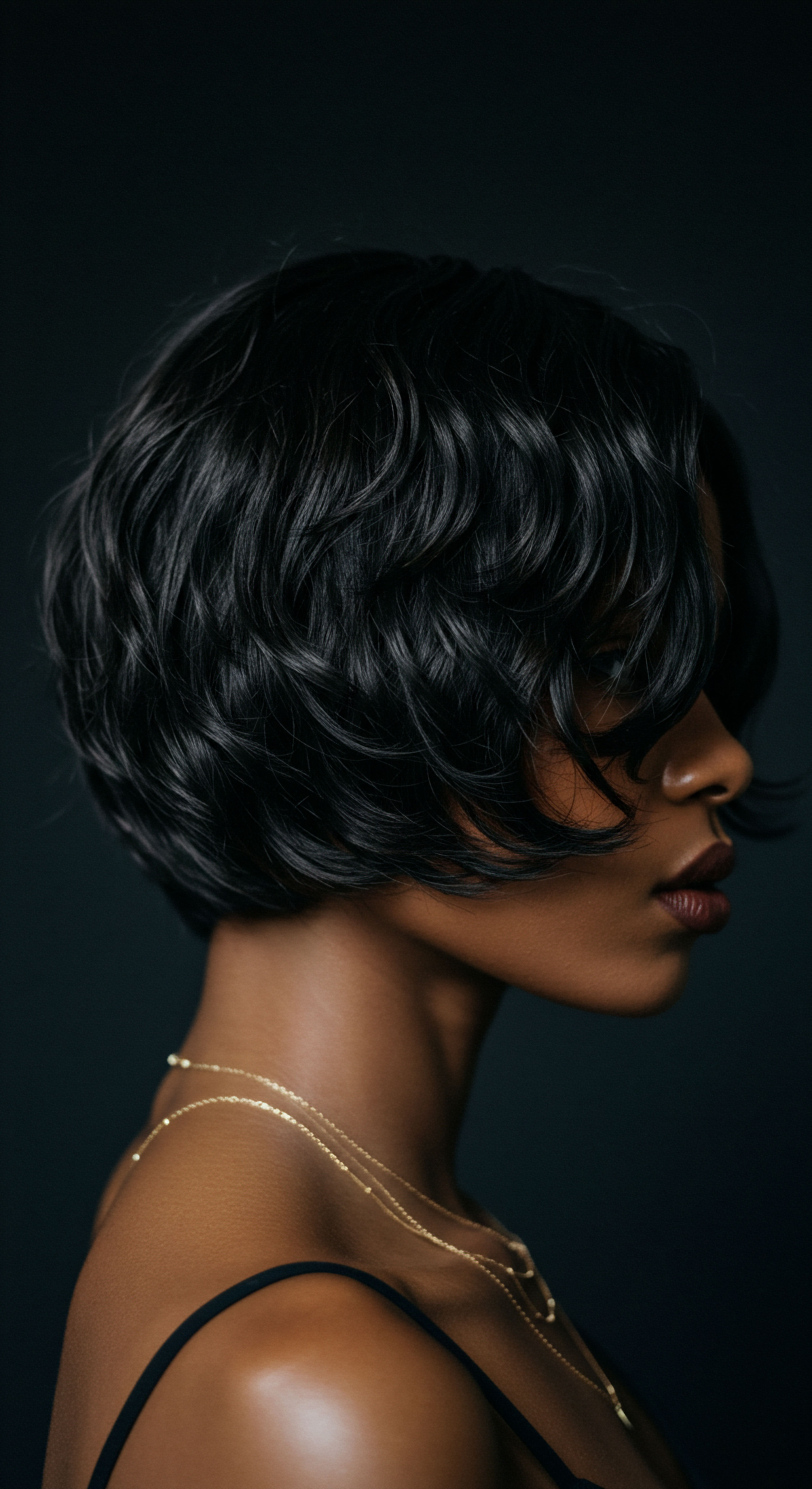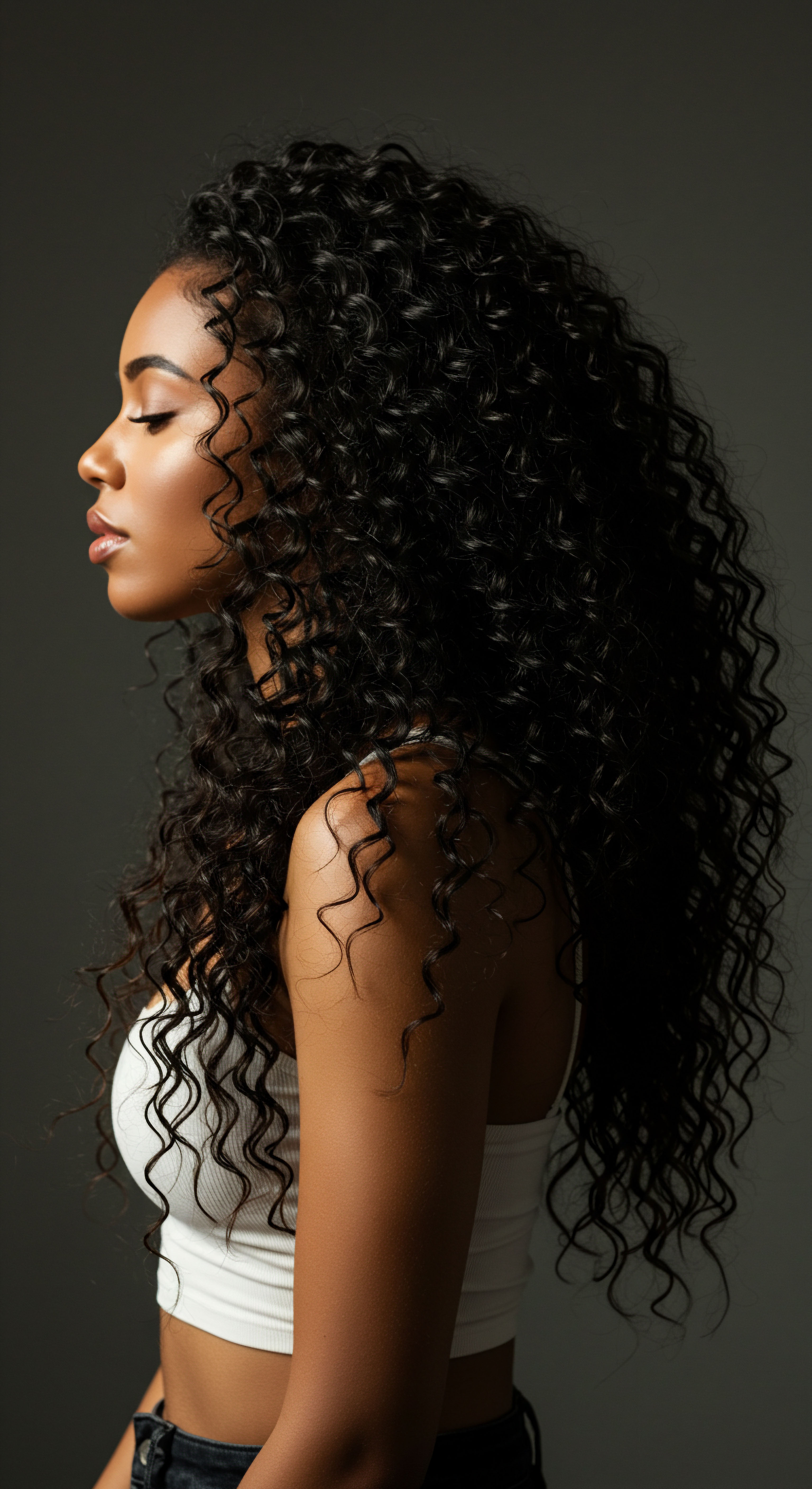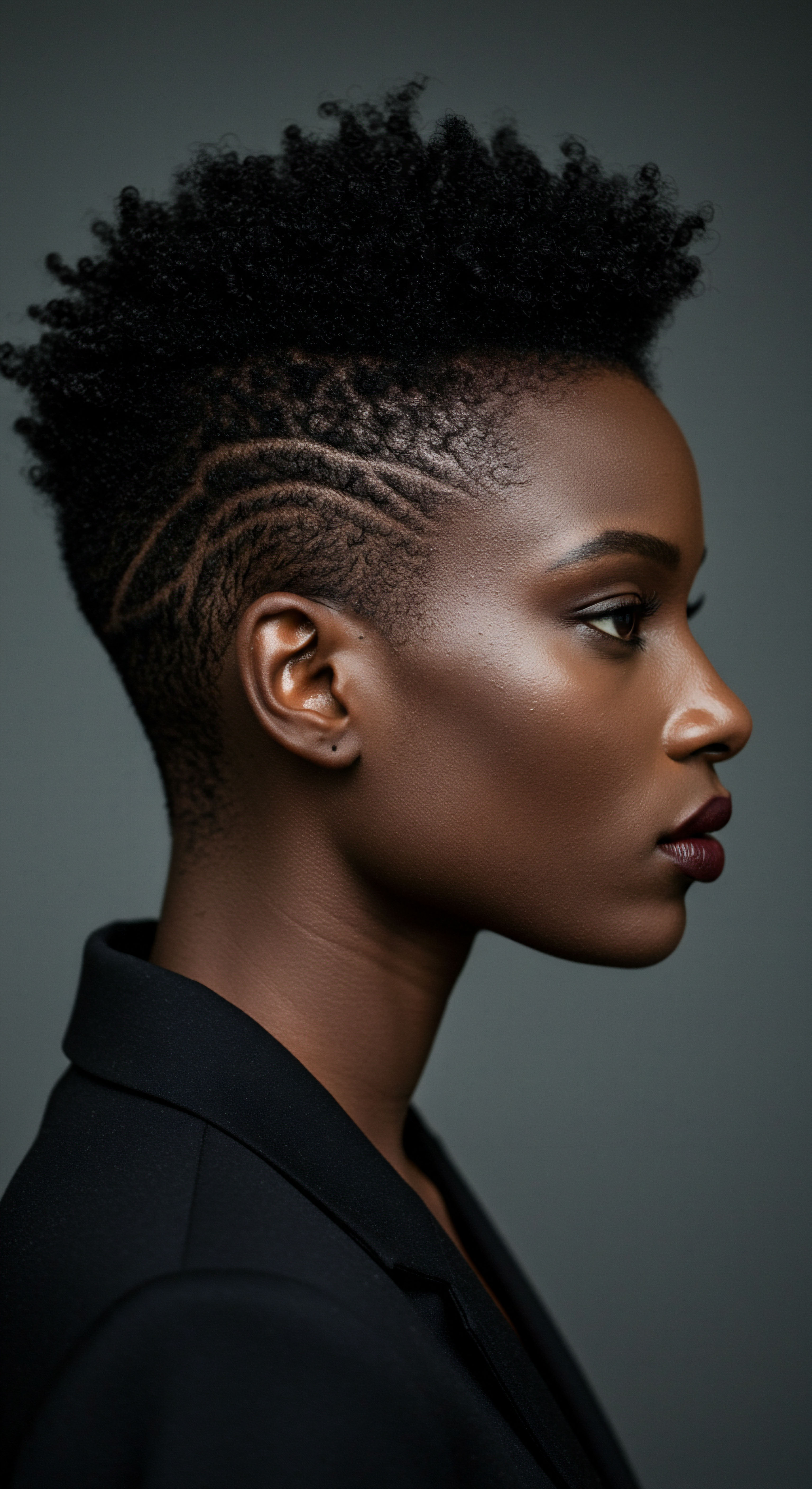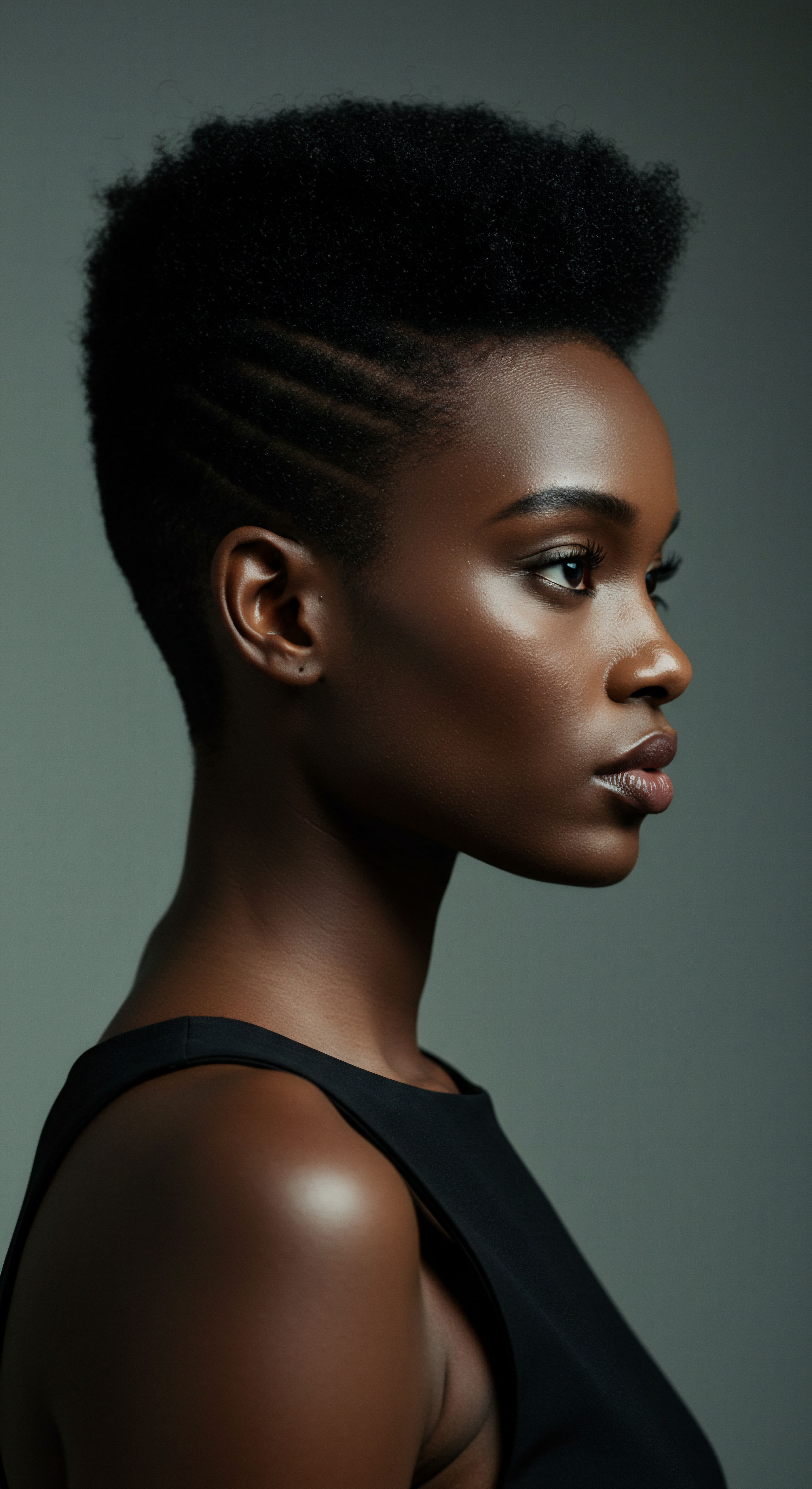
Roots
The quiet hours of night, often perceived as a mere pause in our bustling lives, hold a profound sway over the vitality of our hair. Beyond the visible sheen or curl pattern, a deeper, more elemental process unfolds within the very foundations of our strands while we rest. It is a subtle dance of cellular renewal and hormonal regulation, a hidden rhythm that shapes the resilience and growth of each individual hair. To truly appreciate the connection between our slumber and our hair’s well-being, we must first look to the biological machinery beneath the scalp, understanding how these microscopic factories operate and respond to the subtle cues of our internal clock.

Hair Anatomy and Physiology Specific to Textured Hair
At its fundamental level, hair is a complex biological fiber, emerging from specialized structures called follicles. These follicles are not merely passive conduits; they are dynamic mini-organs, each with its own intricate life cycle. For textured hair, whether wavy, curly, or coily, the follicular architecture presents distinct characteristics. The hair follicle in textured strands often exhibits an elliptical or flat cross-section, causing the hair shaft to grow in a helical or spiraled manner.
This unique curvature influences how natural oils travel down the strand, often leaving textured hair more prone to dryness at the ends compared to straighter types. The irregular distribution of keratin, the primary protein building block of hair, within this curved structure also contributes to its distinct shape and, at times, its delicate nature. Textured Hair, due to its unique formation, can be more susceptible to mechanical stress from daily activities, including styling and even rest.

Hair Growth Cycles and Influencing Factors
Hair growth follows a cyclical pattern, a biological rhythm governing every strand. This cycle has three main phases:
- Anagen ❉ The active growth phase, where cells in the follicle rapidly divide, forming new hair. This period can last from two to seven years.
- Catagen ❉ A brief transitional phase, lasting about two to three weeks, during which hair growth slows, and the follicle begins to shrink.
- Telogen ❉ The resting phase, typically lasting around three months, where the hair stops growing and eventually sheds to make way for new growth.
Numerous elements influence this cycle, including nutrition, genetics, overall health, and, critically, hormonal balance. Disruptions to these factors can prematurely push hairs into the resting phase, leading to thinning or excessive shedding. The body’s ability to maintain these delicate balances is deeply intertwined with our periods of rest.
The quiet hours of night are not merely a pause but a crucial period of renewal for the very structures that shape our hair’s vitality.

The Essential Lexicon of Textured Hair
To discuss textured hair with clarity, a shared understanding of its language becomes helpful. Terms like “curl pattern” refer to the shape of the strand, ranging from loose waves (Type 2) to tight coils (Type 4). “Porosity” describes the hair’s ability to absorb and retain moisture, a characteristic often heightened in textured strands due to their raised cuticles. “Density” refers to the number of individual hair strands on the scalp, while “strand thickness” speaks to the circumference of a single hair.
Understanding these terms allows for a more precise conversation about hair health and how environmental or physiological shifts, such as those related to sleep, might influence specific aspects of textured hair. For example, a change in sleep patterns might affect scalp health, which in turn could impact the environment from which a high-density, low-porosity coil emerges.

How Does the Body’s Internal Clock Shape Hair Follicle Behavior?
The human body operates on a roughly 24-hour cycle, known as the circadian rhythm. This internal clock governs many physiological processes, from sleep-wake cycles to hormone secretion and cellular repair. Intriguingly, hair follicles themselves possess their own circadian clock genes, demonstrating a localized rhythm that influences their growth and activity.
During deep sleep, particularly the non-REM stage, the body enters a repair and growth mode, where cell turnover increases, and tissue repair takes place. This nightly rejuvenation directly supports the anagen phase of the hair cycle.
Studies indicate that circadian clock genes play a role in regulating the hair growth cycle, even though the hair cycle’s periodicity spans weeks to months, a duration far exceeding the daily rhythm. Research using mouse models has shown that disruptions to these clock genes can delay the progression of the hair growth phase, impacting cell cycle control genes. This biological synchronicity means that consistent, quality sleep helps maintain the hair follicle’s natural rhythm, supporting its ability to produce healthy, strong strands. When this rhythm is thrown off, the intricate balance within the follicle can falter, potentially leading to compromised hair health.

Ritual
As the sun dips below the horizon, and the world quiets its daytime hum, a different kind of preparation begins for many. The practical wisdom of caring for our hair, particularly textured strands, often finds its most potent expression in the hours leading up to rest. This segment steps into the realm of applied knowledge, exploring how our nightly routines, whether inherited from generations past or adapted for modern living, intersect with the scientific rhythms of sleep to preserve and enhance hair health. It is a space where the tactile practices of protection and nourishment meet the biological imperatives of rest, offering gentle guidance on how to support our hair’s well-being through mindful nighttime rituals.

The Nighttime Sanctuary Essential Sleep Protection and Bonnet Wisdom
The hours spent asleep can be a period of significant mechanical stress for hair, especially for textured types which are inherently more delicate and prone to breakage. Tossing and turning on conventional cotton pillowcases can create friction, leading to frizz, tangles, and even breakage along the hair shaft. This mechanical wear can weaken the hair follicle over time, impacting its ability to produce healthy strands.
This is where the wisdom of sleep protection, particularly the use of bonnets and silk or satin pillowcases, becomes clear.
- Silk or Satin Pillowcases ❉ Unlike cotton, silk and satin have a smooth surface that reduces friction against hair strands. This minimizes tangling, frizz, and breakage as you move during the night. For textured hair, which can vary in shaft diameter and be more prone to breakage, this reduction in mechanical stress is particularly beneficial.
- Bonnets and Headscarves ❉ A silk or satin bonnet provides an encompassing shield for hair, keeping strands contained and protected from direct contact with bedding. This not only reduces friction but also helps to retain moisture within the hair, a vital aspect for maintaining the suppleness and elasticity of textured hair. Many find that a bonnet helps preserve curl patterns, reducing the need for extensive restyling in the morning and thus minimizing further manipulation and potential damage.
The tradition of covering hair at night has deep roots in various cultures, serving purposes of cleanliness, preservation, and respect. While the materials and specific styles may have evolved, the core principle of safeguarding hair during sleep remains a timeless practice.

Building Personalized Textured Hair Regimens for Night
A truly supportive nighttime regimen is not a one-size-fits-all solution; it is a personalized approach that respects the unique characteristics of one’s hair. Consider these elements when crafting your evening routine:
- Moisture Retention ❉ Textured hair often requires diligent moisture application. Before bed, a light mist of water followed by a moisturizing leave-in conditioner or a touch of hair oil can seal in hydration, preventing dryness that can lead to brittleness and breakage overnight.
- Protective Styling ❉ Loose braids, twists, or a “pineapple” (gathering hair gently at the crown of the head with a soft scrunchie) can keep curls and coils intact, reducing tangling and preserving definition. The aim is to minimize tension on the scalp and hair strands while keeping them secure.
- Scalp Attention ❉ A gentle scalp massage before bed can promote blood flow to the follicles, supporting nutrient delivery. If you use a scalp oil, this is an ideal time for application, allowing it to work its magic overnight.
Nightly care, whether through protective styling or material choice, creates a haven for textured hair, safeguarding its delicate structure against the friction of rest.
A 2021 study on techniques used for hair style maintenance while sleeping noted that patients with afro-textured or curly hair often employ various methods to maintain their hairstyles and avoid time-consuming hair care. This highlights the practical necessity of protective sleep styles in managing textured hair. The study points out that while braids and locks are considered high-risk for traction alopecia if kept for many weeks, the avoidance of further traction at night remains a relevant discussion, suggesting that even these styles benefit from careful management during sleep.

Does Nighttime Hair Care Truly Support Hair Growth?
While the direct link between a specific nighttime hair routine and accelerated hair growth is complex, the indirect benefits are substantial. By reducing mechanical damage, retaining moisture, and supporting scalp health, these practices create an optimal environment for follicles to function. When hair is less prone to breakage and retains its natural moisture, it appears fuller, healthier, and its length is preserved, giving the appearance of improved growth.
The focus here shifts from forcing growth to nurturing the conditions that allow hair to thrive naturally. This approach aligns with a philosophy of wellness, where external care complements internal physiological processes.
| Care Element Silk/Satin Pillowcase |
| Purpose Reduce friction |
| Benefits for Textured Hair Minimizes frizz, tangles, and breakage, retains moisture. |
| Care Element Bonnets/Headscarves |
| Purpose Protect and contain hair |
| Benefits for Textured Hair Shields from friction, locks in moisture, preserves style. |
| Care Element Protective Styles |
| Purpose Minimize tension |
| Benefits for Textured Hair Reduces mechanical stress, maintains curl pattern. |
| Care Element Moisture Application |
| Purpose Hydrate strands |
| Benefits for Textured Hair Combats natural dryness, improves elasticity, prevents brittleness. |
| Care Element These practices contribute to overall hair health and longevity by minimizing nighttime damage. |

Relay
The quiet revolution of understanding our sleep patterns extends far beyond simply feeling rested; it delves into the intricate symphony of our biological systems, including the delicate balance that governs hair follicle health. This segment journeys into the profound interconnections, inviting a deeper contemplation of how the subtle shifts in our nocturnal rhythms reverberate through our physiology, impacting the very genesis of our strands. We move beyond surface observations, seeking to unearth the underlying mechanisms and cultural echoes that define this complex relationship, supported by the quiet authority of scientific inquiry and lived experience.

The Circadian Rhythm and Hair Follicle Synchronicity
Our hair follicles, these tiny, self-contained mini-organs, are not isolated entities; they are responsive participants in the body’s grand circadian orchestration. Research suggests that hair follicles themselves contain a functional circadian clock, expressing genes that regulate their activity over a roughly 24-hour cycle. This localized rhythm influences the cell cycle progression within the follicle, impacting when hair cells divide and grow.
For instance, studies using mouse models indicate that the genes controlling circadian rhythm, like CLOCK and BMAL1, play a role in regulating the hair growth cycle, a process that extends far beyond a single day. Disruptions to these internal clocks, often stemming from inconsistent sleep patterns, can lead to a desynchronization within the hair follicle, potentially hindering its ability to move smoothly through its growth phases.
The influence of the circadian system extends to the very molecules that guide hair growth. Melatonin, often associated with sleep regulation, is also a hormone that exhibits potent antioxidant properties and plays a role in hair follicle biology. Studies indicate that melatonin may prolong the anagen (growth) phase of the hair cycle and protect follicles from oxidative stress. Its production is intrinsically linked to our sleep-wake cycle, meaning that a disturbed sleep pattern can directly affect the availability of this hair-supportive hormone.
Conversely, high levels of cortisol, the body’s stress hormone, are often elevated with sleep deprivation. Cortisol can prematurely push hair follicles into the resting (telogen) phase, leading to excessive shedding.

Beyond the Visible Hair Follicle Health and Systemic Well-Being
The relationship between sleep and hair follicle health is not a simple cause-and-effect; it is a reflection of broader systemic well-being. Sleep deprivation can lead to a cascade of physiological responses that indirectly, yet powerfully, affect hair.
- Immune System Response ❉ Poor sleep can weaken the immune system, potentially leading to increased inflammation around hair follicles. This inflammatory environment can hinder their proper function and even exacerbate autoimmune conditions like alopecia areata, where the immune system mistakenly attacks hair follicles.
- Blood Circulation ❉ During deep sleep, blood flow to the scalp increases, delivering vital oxygen and nutrients to the hair follicles. Insufficient sleep can impair this circulation, depriving follicles of the nourishment they need to produce strong, healthy hair.
- Cellular Regeneration ❉ Sleep is a period of significant cellular repair and regeneration throughout the body, including the skin and hair follicles. A lack of adequate rest can slow down these repair processes, leaving hair follicle cells vulnerable to damage and impacting their ability to function optimally.
The intricate dance of circadian rhythms within our follicles and the body’s systemic response to rest define hair’s very ability to thrive.

Are There Cultural Perspectives on Sleep and Hair Vitality?
Across diverse cultures, the practice of rest and its connection to physical well-being, including hair health, has been acknowledged, albeit often through traditional practices rather than scientific mechanisms. Ancient beauty rituals frequently incorporated nighttime care, not just for aesthetic appeal, but as a holistic approach to preserving vitality. For instance, Ayurvedic traditions in India emphasize nightly scalp oiling and massage, believed to promote blood flow and hair growth, often followed by braiding to protect the strands during sleep. While these practices predate modern scientific understanding of cortisol or circadian rhythms, they intuitively recognized the restorative power of the night and the importance of preparing the body for rest.
In some African and African diaspora cultures, headwraps and bonnets have been used for generations to protect textured hair during sleep, preventing tangles and preserving moisture. This practice, while primarily functional for hair maintenance, also speaks to a cultural understanding of protecting oneself during vulnerable periods of rest, extending care to the physical form. The underlying wisdom in these practices often mirrors contemporary scientific recommendations for mitigating friction and maintaining scalp health, demonstrating a long-standing, culturally embedded awareness of how nocturnal habits influence hair’s condition.

Uncommon Insights ❉ The Sleep-Alopecia Areata Connection
While the general understanding of sleep deprivation and hair thinning often points to stress-induced telogen effluvium, a more specific and less commonly discussed link exists with alopecia areata (AA). Alopecia areata is an autoimmune condition where the immune system mistakenly attacks hair follicles, leading to patchy hair loss. Several studies have pointed to a compelling association between sleep disturbances and the onset or exacerbation of AA. For instance, a 2022 study involving 102 adults, half with alopecia areata and half without, indicated a complex connection between AA and poor sleep.
The researchers observed that insufficient sleep can trigger various autoimmune disorders, and AA frequently accompanies other autoimmune conditions. This suggests that inadequate sleep might not directly cause AA, but it could act as a significant trigger, exacerbating an underlying autoimmune predisposition.
Furthermore, a larger study involving over 25,000 individuals found that those with sleep disorders faced a higher risk of developing alopecia areata. This underlines the importance of good sleep habits and addressing sleep disorders in the context of preventing hair loss, particularly for those with a predisposition to autoimmune conditions. The cyclical nature of this relationship is also noteworthy ❉ having alopecia areata can contribute to stress, anxiety, and depression, which in turn can lead to sleep disturbances, creating a self-perpetuating cycle of compromised hair health and restless nights. This nuanced connection highlights that the impact of sleep on hair goes beyond simple shedding, reaching into the complex realm of immune system regulation and autoimmune responses.
| Sleep Issue Sleep Deprivation |
| Hormonal/Physiological Impact Increased Cortisol, Reduced Melatonin, Impaired Circulation |
| Hair Condition Association Telogen Effluvium, General Thinning |
| Sleep Issue Sleep Disorders |
| Hormonal/Physiological Impact Immune Dysregulation, Chronic Stress |
| Hair Condition Association Alopecia Areata, Androgenetic Alopecia (indirect) |
| Sleep Issue Disrupted Circadian Rhythm |
| Hormonal/Physiological Impact Follicle Cell Cycle Disruption |
| Hair Condition Association Slower Hair Growth, Weakened Strands |
| Sleep Issue Consistent, quality sleep supports systemic health, which in turn promotes hair vitality. |

Reflection
The quiet hours of night, often taken for granted, emerge as a powerful, unseen force in the ongoing vitality of our hair. The scientific understanding of sleep’s role in hormone regulation, cellular repair, and even immune system balance, coupled with the enduring wisdom of cultural practices, paints a complete picture. Our hair, particularly textured strands, does not simply rest when we do; it engages in a complex, restorative dance. A deeper understanding of these nocturnal rhythms offers not just a path to healthier hair, but a gentle reminder of the profound connections within our own bodies, inviting us to honor the quiet power of rest.

References
- Baron, E. D. et al. “The effect of shift work and poor sleep on self-reported skin conditions ❉ A survey of call center agents in the Philippines.” Clocks and Sleep, 2019.
- Oyetakin-White, P. et al. “Does poor sleep quality affect skin ageing?” Clinical and Experimental Dermatology, 2015.
- Phillips Global Sleep Survey, 2019.
- Rebello, L. “Ancient Ayurvedic Hair Care Rituals We Need to Bring Back in 2024.”
- Shum, L. et al. “Clock genes, hair growth and aging.” Aging, 2010.
- Slominski, A. T. et al. “Melatonin and the Human Hair Follicle.” Journal of Drugs in Dermatology, 2023.
- Sun, H. et al. “Melatonin regulates the periodic growth of secondary hair follicles through the nuclear receptor RORα.” Frontiers in Physiology, 2023.
- Sung, C. T. et al. “Techniques Used for Hair Style Maintenance while Sleeping May Be a Risk Factor for Traction Alopecia.” Skin Appendage Disorders, 2021.
- Typology. “The consequences of a lack of sleep on your hair.” 2024.
- Wimpole Clinic. “Can Lack of Sleep Cause Hair Loss?”
- Ye, L. et al. “Severity of Androgenetic Alopecia associated with poor sleeping habits and carnivorous eating and junk food consumption— A web-based investigation of MPHL in China.” ResearchGate, 2024.